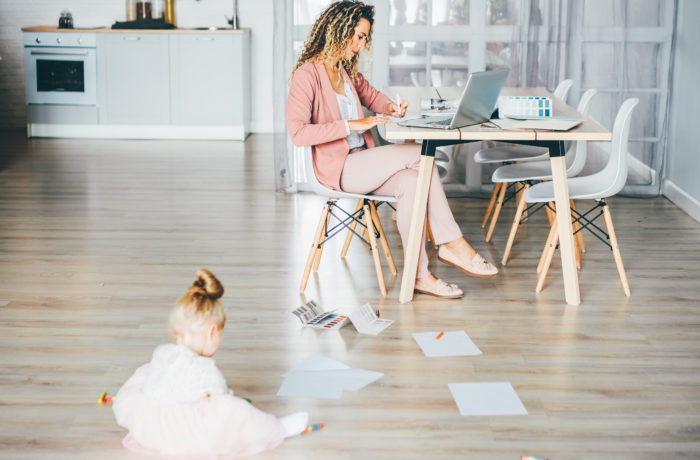After reading Sabrina’s post on Business Insider about how she and her company are bringing new meaning to flexibility when it comes to careers and parenting, we knew we had to learn more — and meet her! What follows is a Q&A about how the flex culture came to be at Palo Alto Software. We’re thrilled that she’ll also be joining us as a special guest at our SXSW Core Conversation: Work & Flexibility: Why Women Must Lead the Way.
A snippet of the piece that went viral on Business Insider:
“As CEO of Palo Alto Software, I have made it a priority to encourage my employees to do whatever they need to succeed at work while raising a family. We have a room in our office designed specifically for children to relax after school while their parents are still working. We do not have strict hours for the sake of having them. If someone needs to leave work early to take their child to the doctor or work from home, we’ll never single them out. But they’re always expected to do what’s asked of them and more.” – Sabrina Parsons
 1. Tell us about the most prevalent cultural & behavioral norms at Palo Alto Software (PAS). What is it most okay to do?
1. Tell us about the most prevalent cultural & behavioral norms at Palo Alto Software (PAS). What is it most okay to do?
Palo Alto Software is a company that believes that work product and results are the way employees should be judged.
We do not believe in face time, or evaluating performance based merely on time spent in the office. We want employees to have flexibility, and make their own decisions about work hours, while keeping in mind that being part of a team and collaborating is very effective for innovation and creativity.
We think employees who go home at a decent hour, and do whatever it is they like to do in their free time — be it walk their dog, going mountain biking, running, or hanging out with their family, are happy employees that also don’t burn out and are able to be more creative and innovative. An employee who is happy and productive is a loyal employee who cares about our company and their work product.
We are also a company that thinks it is perfectly fine to bring a child and even a baby (yes a baby!) into the office. We have had five newborn babies since I’ve been at Palo Alto Software, who came to the office everyday with their mothers until they were 4-6 months old. This allowed the moms, who were nursing, to bond, and be with their babies and practice attachment parenting, while still coming to work and doing the job that they loved. We have had just as many moms take maternity leave and then come back after three months with their babies in daycare, so it’s not like babies are here in the office because we don’t give maternity leave. They are here because their working moms have wanted to continue their careers, and we give them that choice.
On a day when there is no school (which seems like too often these days due to budget cuts in Oregon public schools) there is likely to be 5-6 kids in our office. Their parents need to bring activities, and the kids need to be able to behave appropriately. We encourage parents to split time between home and the office when they have their kids all day for unexpected reasons, as no kids wants to be in an office for eight hours. I love giving our employees this sort flexibility and them knowing that they will not be judged or be jeopardizing their career just because their kids are at the office.
 2. How did this set of norms come to be? Did someone or a group spearhead it? Was another company doing something similar?
2. How did this set of norms come to be? Did someone or a group spearhead it? Was another company doing something similar?
This came to be when I had my first son, 9.5 years ago. I was not running the company, but was running Marketing Communications and Business Development. I just could not find a daycare for a very small infant that I liked, and I was comfortable with. To be honest I just avoided the issue, and then when he was born. After a few weeks off, I couldn’t stay away from work—so I just brought him with me. From then on, I realized that done appropriately, there was no reason for babies to not be able to come into the office here and there. A very young baby who is nursing, really doesn’t cause much trouble. I was lucky I know, to not have colicky babies, and my babies were really “easy” as long as they lived in the sling around my neck, nursing on demand under a nursing cover. Of course it is exhausting, and my back hurt, but it was a compromise I was thrilled with. I repeated this with my next two sons when they were born.
Once my babies were 4-5 months old they did need full time care, not in the office. At that point babies are getting more mobile, want to play and interact, and really do need someone to focus on them 100%. I found a small at home daycare with only two other babies, and both my first two went there, until my husband and I did the math and realized that a full time nanny was really not that much more. We have a fabulous nanny who we all love, and has made life much easier for all of us.
But even today when one of the kids is sick (not feverish and not horribly sick- but too sick for school) they come to the office with me. They love it, and I love it. Why not let them come in, watch movies, read, and sleep, which is what they would do at home. In fact, coincidentally as I write this, my oldest is in the office, feeling a little under the weather.
I can monitor my kids’ sickness, give them hugs and kisses, and be with them when they most want me, but in a way that allows me to keep working. Other employees are afforded the same privileges, and they all appreciate the flexibility. No one, though, brings his or her child in every day.
3. What is it about your company’s culture that makes it possible for a flex program to work?
As much as we can, we focus on what is produced and whether goals and objectives are achieved. Some roles do require a little less flexibility, like customer service, where we need to phones to be answered eight hours a day, five days a week. With customer service, our manager works with team members that require periodic flexibility, and they can often times do work from home answering customer emails and answering our live web chats. We have a customer service employee who is pregnant right now, and we will be working with her to offer her as much flexibility as possible, and ways that she can work from home as she wants/can in order to let her stay home as long as possible with her new baby. She will also be taking her three-month maternity leave.
It’s all about being open minded, up for problem solving, and focusing on results. If you combine those things then you can create a culture that values people and not just the hours they are at the office.
4. How do your flex programs actually work? Who is it open to? What do employees say about these policies?
The way the flex program works, is by doing a few things right:
- Hire people that are smarter than you, and excel at their careers. These people will always give you more—because that is who they are. If you afford them all the flexibility in the world, they will never disappoint, and will be the first ones to hop online at 2am when a web server goes down.
- Hire managers that want the same flexibility, and excel at producing results. Someone who understands it is not about hours but what you produce, and the quality of what your produce, is going to want the same out of their team.
- Hire people you don’t have to babysit. The minute you think about where that employee is, whether they are actually working, whether they are abusing the flexibility, is the minute we realize we hired the wrong person. We don’t want to babysit, and as a management team we suck at micro management. We need people who want to own their job, and want to advance their careers by being excellent. These people don’t need to be micromanaged, and these people thrive with flexibility and autonomy.
5. Have these initiatives helped with your recruiting?
Yes, I think they have. Our engineering team is 30% women. Our management team is 40% women. And beyond recruiting I think these policies help with retention. Our employees enjoy this environment and it creates a great team. Here is another interesting metric – in the span of 11 months there will be 7 babies born out of 48 employees. I like to think that this is a measure of happiness and security at Palo Alto Software!
6. How would you advise other companies thinking about implementing something similar?
I think you need to be willing to change the “norm” and not worry about perception. Other people will disagree. Other people will say it is “un-professional”. Other people will criticize. Women have faced these challenges throughout history. We can come together and demand that the paradigm be changed, If there can be daycares in large corporate businesses, why can’t there be policies about school age kids being allowed to periodically come into the office? Why can’t we demand that work product be the measurement rather than pure hours in the office? Why must we work within the norms men created in the “Mad Men” era? It’s time to push feminism to the next level and demand that working mothers be judged on their accomplishments, their performance, and their success, and not how many kids they have, and if they “want” to go to their swim practice, or doctor’s appointment.
Search flexible job opportunities from Palo Alto Software!





